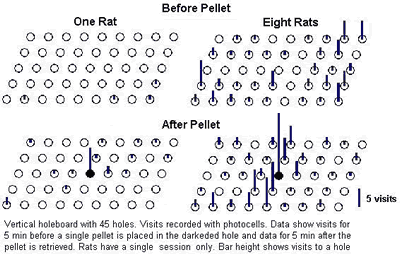
Genesis of learning: the behavioral effects of a single reinforcement
I.H. Iversen
Department of Psychology, University of North Florida, Jacksonville, FL, U.S.A.
The general principles of reinforcement are well understood. However, the underlying behavioral mechanisms that make reinforcement principles work are not well researched. Research has shown that the microstructure of behavior during transition periods can in fact be quite systematic and understandable when behavior is analyzed conditional upon the environmental events that guide the transition [1].

Figure 1.
The research reported here builds upon this earlier work and takes a fresh look at the changes that take place when one zooms in on the microstructure of behavior during the very first moments of learning. Because reinforcement is critical for learning, the research begins by looking at what happens to behavior when reinforcement is presented. Several experiments examined how a single reinforcement influences the ongoing stream of behavior. In one set of experiments, food-deprived rats are presented with food pellets delivered unpredictably and response-independently.
Figure 1 illustrates data for one rat from a single 30-min session with response-independent reinforcement delivered on a variable-time 1-min schedule; several rats were used. Bars show the probability of a given response during a 15-s period after reinforcement conditional upon which response happened to occur right before that reinforcement. The data indicate that the response that is most likely to occur after a given reinforcer is the same response that occurred right before that particular reinforcer. Hence, a single reinforcement can momentarily strengthen the response that happens to precede it even when the response does not produce the reinforcer. Control conditions show that this effect is not simply due to a more general mechanism of one response being most likely to follow itself. Additional research has also identified a momentary induction effect of reinforcement in experiments that present only a single reinforcement to each rat in one 10-min session. A box with a vertical holeboard records visits to each hole [2]. After a short period of habituation, a single food pellet is presented in one of the holes.
Figure 2 shows data before and after pellet retrieval for one rat (left) and accumulated data for 8 rats (right). The pellet was presented in the darkened target hole. The height of each bar shows the duration of visiting the corresponding hole. Results showed an increased frequency of visits to the target hole and an increased visit frequency to neighboring holes after pellet retrieval. The experiments illustrate the basic mechanisms of response strengthening and induction that take place at the moment learning begins.

Figure 2.
Paper presented at Measuring Behavior 2000, 3rd International Conference on Methods and Techniques in Behavioral Research, 15-18 August 2000, Nijmegen, The Netherlands